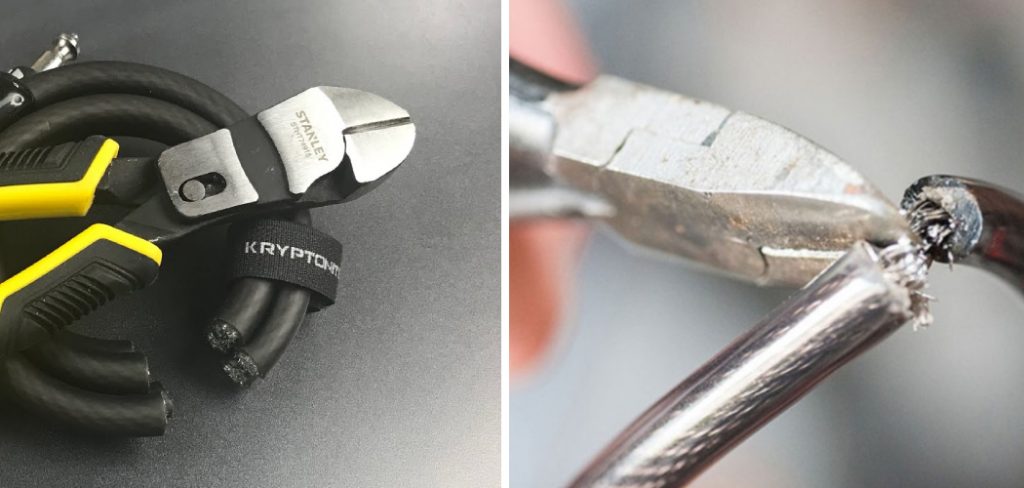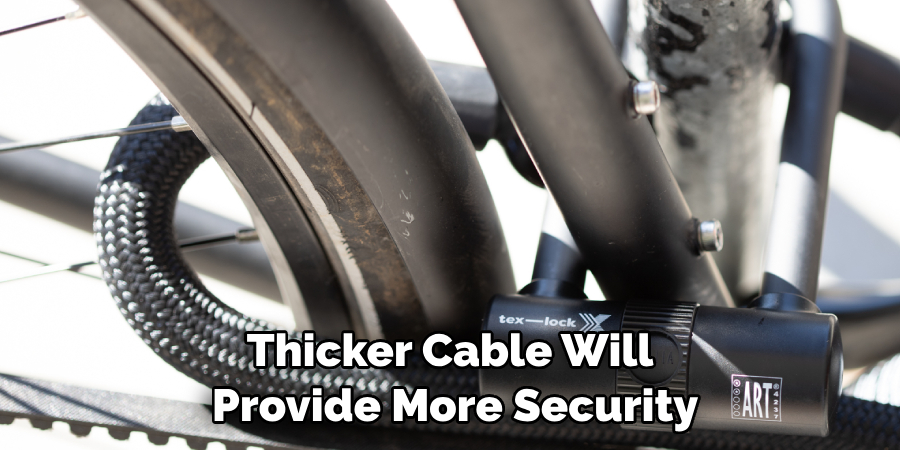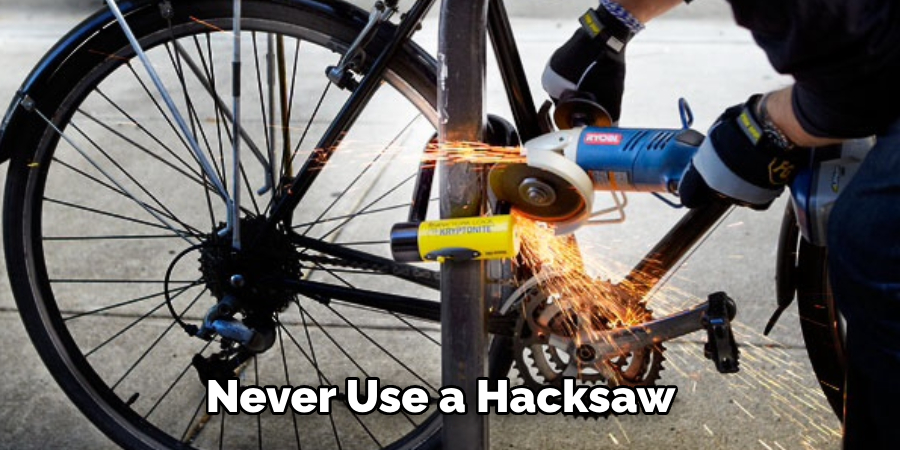Are you ready to take your biking skills to the next level? With a cable bike lock, you can keep your bicycles and other cycles secure when unattended. But knowing how to cut a cable bike lock properly is an integral part of using these locks effectively for safety and security purposes.

Whether you’re a beginner or an experienced cyclist, here are the steps to help you cut a cable bike lock without causing any damage.
In this blog post, we’ll outline tips about properly choosing your cables for maximum security and provide step-by-step instructions on cutting down the most popular types of cable bike locks. With this knowledge, you can rest easy knowing that protecting your beloved two wheels is no longer a major hassle!
What Will You Need?
Before you can begin cutting a cable bike lock, you must have certain tools on hand. The requirements will vary depending on which type of cable bike lock you’re using. Here are some of the most common tools that may be necessary for this task:
- Bolt cutters or a hacksaw
- Flashlight
- Allen wrenches
- Lubricant or WD-40
- Cable cutters
By having these items ready, you’ll be better positioned to quickly and efficiently cut the cable bike lock without any major issues.
10 Easy Steps on How to Cut a Cable Bike Lock
Step 1. Safety First:
Before beginning, ensure that you’re wearing proper safety gear. This includes gloves to protect your hands and safety glasses to shield your eyes from flying metal shards that could be potentially hazardous. If you’re dealing with a very large lock, it may be helpful to have a friend hold the bike and the cable while you cut.
Step 2. Choose your Cable:

When selecting which type of cable bike lock to use, consider factors like thickness, material, and length. A thicker cable will provide more security as cutting is more difficult. Make sure that you inspect the material beforehand to ensure that it is strong and durable enough for your needs.
Step 3. Prepare the Cable:
Remove any rust or corrosion on the cable by using a wire brush, WD-40, lubricant, or an allen wrench. This will help make the cutting process easier and more efficient. Try to clean both sides of the cable and leave no dirt on it.
Step 4. Position the Cable:
Next, you need to position the cable properly before cutting it. Position the cable at waist level or higher. This would make cutting easier, as cable bike locks can be tough and require some force. You can use a workbench clamp or get someone to hold the cable while you cut. Ensure the part of the cable you intend to cut is easily accessible and free from any obstructions.
Step 5. Cut the Cable:
Now, it’s time to cut the cable. Start cutting the cable using your chosen tool, whether that be bolt cutters, a hacksaw, or cable cutters. Apply steady pressure and use both hands to ensure an even cut.
If you use a hacksaw, you might need more force. Remember that it may take a few minutes to get through the cable completely, depending on the thickness. Always remember to stay patient and maintain your safety throughout the process.
Step 6. Inspect the Cut:

Inspect the cut after successfully cutting the cable to ensure it’s clean and even. If any jagged edges or metal strands are protruding from the cut, use a file or sandpaper to smooth them out. This will prevent any potential injury when handling the cut cable in the future. It also ensures that the lock will function smoothly when you use it next time.
Step 7. Secure the Cable:
After cutting the cable, it’s important to secure it properly. Wrap the cut ends of the cable with electrical tape or a durable plastic coating. This will help prevent the ends from unraveling and will also protect the metal from weathering and rust.
Step 8. Test the Cable:
Once you’ve secured the ends, test the cable by trying to lock and unlock it. Ensure the lock mechanism works smoothly and the cable is properly secured on your bike. You should revisit the previous steps and correct any potential problems if there are any issues.
Step 9. Regular Maintenance:

It’s essential to maintain your cable bike lock regularly to ensure it continues to provide reliable security. Check the cable and the lock mechanism regularly for signs of wear and tear, rust, or any other damage. Use a lubricant or WD-40 to keep the cable and the lock mechanism smooth and rust-free. If you notice significant damage or wear, it may be time to replace your cable bike lock.
Step 10. Safekeeping:
Store your cable bike lock in a dry, cool place out of direct sunlight when not in use. This will help prolong the life of your lock by preventing rust and other weather-related damage. Remember, taking care of your bike lock will keep your bike secure for longer!
Following these ten steps, you can easily cut a cable bike lock without causing any damage. All left to do now is grab your tools and get started!
5 Additional Tips and Tricks
- Make sure to lubricate the bolt cutters before use. This will make your job easier and help prevent wear and tear on the cutting blades.
- Cut slowly, in small increments. This will give you more control over how much pressure you’re putting on the cable as it is being cut, reducing the risk of accidentally damaging other parts of your bike or your bolt cutters.
- Use two pairs of locking pliers to secure the cable before cutting it. This will help keep the cable in place and prevent any slippage as you cut it.
- Make sure you have a plan B if your bolt cutter blades get dull during the job – having an angle grinder around can help you switch to cutting with it if needed.
- Always be aware of your surroundings, and never leave your bike unattended while cutting the lock. Make sure that if someone does come by, they don’t see what you’re doing – it could lead to theft of your bike or worse!
Lastly, when cutting the bike lock, don’t forget to dispose of it properly. A damaged bike lock should never be reused and can be a safety risk if left around. It can also be recycled in many cities, so checking your local recycling program’s acceptance status is best.
5 Things You Should Avoid

- Never use a hacksaw or other sharp tools to cut the lock – these can easily break and cause injury.
- Don’t try to force too much pressure on the cable while cutting, as this could cause the blade of your bolt cutter to become damaged.
- Attempting to cut a hardened steel bike lock with a bolt cutter will likely be unsuccessful, so it’s best to avoid this altogether.
- Never use a power tool like an angle grinder without proper safety equipment and knowledge of how to operate the tool.
- Avoid leaving your bike unattended while cutting the lock, as this can attract unwanted attention or lead to theft.
By taking these precautions, you can successfully cut a cable bike lock without the risk of injury or theft. Always wear safety goggles and gloves when using bolt cutters and other tools, and never force too much pressure on the cable as you are cutting.
Can I Break a Bike Lock With a Hammer?
Breaking a bike lock with a hammer is generally not recommended, as it can damage your lock and other bike parts. Additionally, using too much force to break the lock can cause injury to yourself or others nearby. If you are determined to break the lock with a hammer, ensure you have proper safety gear (such as goggles) and practice in an area away from people or passing cars.
It is also important to note that a hammer should only be used as a last resort when no other options are available. In most cases, you can cut the lock with bolt cutters and replace it afterward.
Breaking a bike lock with a hammer is possible but not recommended. Using a bolt cutter and following the proper safety precautions when cutting your lock is much better. This will help extend the life of your lock, and you won’t have to worry about damaging other parts of your bike or injuring yourself in the process.
Conclusion
To sum it up, cutting a bicycle cable lock when you’ve lost your keys can be a daunting job. But with the right material and some patience, you can do it without breaking a sweat. Just take your time to practice and get the hang of the technique; soon enough, you’ll be fully prepared in an emergency.
Plus, having the power to unlock your bike will give you that extra confidence to fix something yourself – and who knows, maybe even leave people around you amazed. So don’t hesitate; start breaking those locks today!
Hopefully, the article on how to cut a cable bike lock was helpful and you are now more confident in unlocking your bicycle without the need of a key. Now that you’ve finished reading this article get out there and start unlocking your bike – safe travels!
About
Safety Fic is a distinguished figure in the world of Diy design, with a decade of expertise creating innovative and sustainable Diy solutions. His professional focus lies in merging traditional craftsmanship with modern manufacturing techniques, fostering designs that are both practical and environmentally conscious. As the author of diy, Safety Fic delves into the art and science of Safety Fic-making, inspiring artisans and industry professionals alike.
Education RMIT University
(Melbourne, Australia) Associate Degree in Design (Safety Fic) Focus on sustainable design, industry-driven projects, and practical craftsmanship. Gained hands-on experience with traditional and digital manufacturing tools, such as CAD and CNC software.
Nottingham Trent University
(United Kingdom) Bachelor’s in diyfastly.com and Product Design (Honors) Specialized in product design with a focus on blending creativity with production techniques. Participated in industry projects, working with companies like John Lewis and Vitsoe to gain real-world insights.
Publications and Impact
In diy, Safety Fic his insights on indoor design processes, materials, and strategies for efficient production. His writing bridges the gap between artisan knowledge and modern industry needs, making it a must-read for both budding designers and seasoned professionals.
